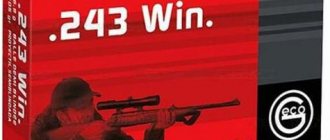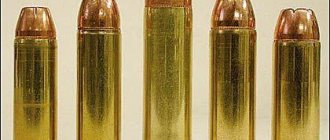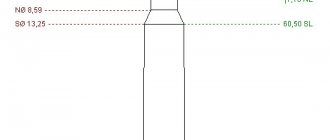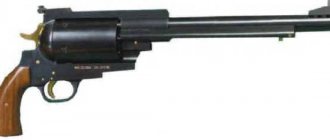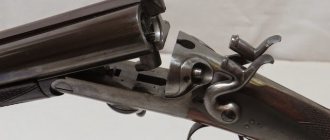| .338 Winchester Magnum | ||||||||||||||||
| .375 H&H Magnum (left) .338 Winchester Magnum (right) US Quarter for scale | ||||||||||||||||
| Type | Rifle | |||||||||||||||
| Country of origin | USA | |||||||||||||||
| production history | ||||||||||||||||
| Creator | Winchester Duplicate Weapon | |||||||||||||||
| Production | 1958 | |||||||||||||||
| Characteristics | ||||||||||||||||
| Based | .375 Holland and Holland Magnum | |||||||||||||||
| shell type | Magnum with belt | |||||||||||||||
| neck diameter | 0.369 mm (0.015 pg) | |||||||||||||||
| shell diameter | 0.491 mm (0.019 pg) | |||||||||||||||
| base diameter | 0.513 mm (0.02 pg) | |||||||||||||||
| rim diameter | 0.532 mm (0.021 pg) | |||||||||||||||
| rim thickness | 0.05 mm (0.002 pg) | |||||||||||||||
| shell length | 2.5 mm (0.098 pg) | |||||||||||||||
| total length | 3.34 mm (0.131 pg) | |||||||||||||||
| shell volume | 86 | |||||||||||||||
| Maximum pressure | 64,000 psi | |||||||||||||||
| used in | Large rifle magnum | |||||||||||||||
| ballistic characteristics | ||||||||||||||||
| ||||||||||||||||
| Test Barrel Length: 24 mm (0.945 in) | ||||||||||||||||
| Source: Precision Powder [1] | ||||||||||||||||
| [edit data in Wikidata] | ||||||||||||||||
. 338 Winchester Magnum
is a .338 in (8.6 mm) centerfire rifle cartridge introduced in 1958 by Winchester as part of their Magnum line of belted cartridges. The .338 win magazine was developed by shortening the case of the .375 Holland & Holland cartridge. Magnum. [ 2 ] so that it can be used in a standard action and the neck can be adjusted to accommodate a .338″ projectile. The .338 Wine Magazine is very popular among hunting guides in Alaska and is considered the best choice to support their clients during grizzly bear hunting when it is necessary to stop one of these animals [3] It is also the most popular medium caliber cartridge in North America and is very popular for hunting against wapiti due to the energy it retains over long distances, for this reason a wide selection of rifles chambered for this caliber can be found on the market. [4] with an action length equal to the length of a .30-06 Springfield or .300 win mag.
cartridge history
The origins of the .338 Winchester Magnum can be traced back to experiments conducted by Charles O'Neill, Elmer Keith and Don Hopkins. In the 1940s with .333 caliber bullets, the use of .0333 (8.5mm) projectiles became more common due to its popularity in Europe. O'Neill, Keith and Hopkins developed the .333 OKH, based on the . the 30-06 Springfield, which had its neck diameter increased to accommodate .333-inch bullets, and the .334 OKH, which was developed by shortening the .375 Holland & Holland Magnum case and adjusting the neck to accommodate .333-inch bullets. caliber bullets."
The .338 Winchester Magnum was introduced in 1958 along with the . 264 Winchester Magnum and .458 Winchester Magnum; all based on the .375 H&H magnum, shortened to 2500 inches (63.5), the same as the .334 OKH. Winchester introduced a 200-grain load that reaches 3,000 fps, a 250-grain that reaches 2,700 fps, and a 300-grain that reaches 2,450 fps. Winchester later introduced the Winchester Model 70 Alaskan chambered in .338 win mag, which left no doubt about the caliber's intended usefulness as an option for hunting heavy and dangerous Alaskan game such as grizzly bears and moose.
Performance[edit]
This cartridge is capable of propelling a 225-grain (14.6 g) bullet to a velocity of 2,800 ft/s (850 m/s), generating 3,918 ft-lbf (5,312 J)[7], delivering energy values at 200 yards. which are roughly equivalent to the energy values of a .30-06 Springfield[8] at the muzzle. Bullets are available in a variety of designs and weights from 150 [9] to 300 grains. SAAMI pressure level is 64,000 psi.
The .338 Winchester Magnum can fire heavier bullets than .30 caliber (7.62mm) cartridges. The most common bullets for the .338 Winchester range from 200gr (13gr) to 250gr (16gr). Typical bullet weights for factory ammunition are 200 g (13 g), 210 g (14 g), 225 g (14.6 g), and 250 g (16 g). Typical velocities for a bullet of this weight range from 2,960 ft/s (900 m/s) for the 200 gr (13 g) to approximately 2,660 ft/s (810 m/s) for the 250 gr (16 g) bullet, each generates approximately 3900 ftlbf (5300 J) of energy. This is approximately 25% more energy than the 30-06 Springfield.
Winchester Ballistic Silvertip (SBST338) 200 gr (13 g) ammunition withstands over 1,600 ft-lbf (2,200 J) at 625 yd (572 m) and has energy of 1,000 ft-lbf (1,400 J) at 800 yd (730 m) ). Winchester Combined Technologies' Accubond ammunition (S338CT) extends the range for these energy levels even further to 675 yards (617 m) and 850 yards (780 m), respectively.
Hornady's SST Superformance 200 gr (13 g) load has a muzzle energy of 4,076 ft⋅lbf (5,526 J) at 3,030 fps. It supports 1899 ft⋅lbf (2575 J) at 2068 fps at 500 meters. The Hornady SST Superformance 225 gr (14.6 g) load has a muzzle energy of 4,029 ft⋅lbf (5,463 J) at 2,840 fps. It supports 2025 ft⋅lbf (2746 J) @ 2014fps @ 500 meters. This is for the 24" test barrel compared to the 27.5" test barrel for the 338 Lapua. The numbers will be higher when shot from the 27.5-inch test barrel, but still 150 fps slower than the 338 Lapua when tested with the same barrel length.
The recoil of this caliber is quite heavy, with about 31 ft⋅lbf (42 J) of recoil energy in the 9 lb (4.1 kg) rifle. This is approximately twice the recoil of the average .308 Winchester. Such heavy recoil can be reduced by using properly designed stocks and shock absorbers. By comparison, this cartridge has less recoil than other more powerful .338 rifles such as the .338 RUM, .340 Weatherby, and .338 Lapua.
Design and specifications
The .338 Winchester Magnum follows modern cartridge design in an effort to maximize case powder capacity without sacrificing chambering and ejection reliability. The .338 Winchester Magnum is modeled after the .375 H&H Magnum case, shortened to 2500 (63.5 mm) and chambered for a 0.338 inch (8.6 mm) bullet. The case has a capacity of 86.0 grains of water (5.58 cc) and follows the design of a line of cartridges that Roy Weatherby also developed in the 1940s to feed from a standard length action such as the .257 Weatherby Magnum. 270 Weatherby Magnum and 7mm Weatherby Magnum, for which Winchester supplied the main brass until 1948.
Both the Permanent Commission Internationale de la Portage (CIP) and the Sporting Arms and Ammunition Manufacturers Institute (SAAMI) regulate and regulate the specifications surrounding the .338 Winchester Magnum.
Performance
This cartridge is capable of pushing a 225 grain (14.6 g) projectile at 2,800 ft/s (850 m/s), generating 3,918 lb/ft (5,312 J) of energy, delivering the same energy out to 200 yards. generates . 30-06 Springfield at the mouth of the canyon. [ 5 ] [ ] Ammunition availability is very wide in design, construction and projectile weight, from 150 to 300 grains. [7] SAAMI pressure level is 64,000 psi.
The .338 Winchester Magnum is capable of firing projectiles heavier than .30 caliber cartridges, with projectile weights ranging from 200 to 250 grains at an average velocity of 2,960 to 2,660 feet per second.
The 200-grain Winchester Ballistic Silvertip (SBST338) ammunition holds over 1,600 ft-lb (2,200 J) at 625 yd (572 m) and 1,000 ft-lb (1,400 J) at 800 yd (730 m). Accubond (S338CT) ammunition extends these energy levels to even 675 yards (617 m) and 850 yards (780 m), respectively.
Hornady's 200-grain SST Superformance ammo generates 4,076 ft-lbs of energy and a muzzle velocity of 3,030 ft/sec while maintaining 1,899 ft-lbs at 2,068 ft/sec at 500 meters. The same ammo with 225-grain projectiles produces 4,029 lb/ft at the muzzle and 2,840 fps and maintains 2,025 lb/ft at 2,014 fps at 500 meters from a 24-inch barrel.
The .338 Winchester Magnum recoil is 31 lb from a 9 lb (4.1 kg) rifle, twice the average recoil of the .308 Winchester. However, the .338 win's magazine recoil is less than that of other .338 calibers such as the .338 Remington Ultra Magnum, .340 Weatherby Magnum, and .338 Lapua Magnum, all of which are fed by a long Magnum action.
.338 Blaser Magnum cartridge
The .338 Blaser Magnum cartridge, along with three other Blaser ammunition, hit the market in 2009. All four cartridges were the fruits of cooperation between the manufacturers Blaser and Norma. The .338 Blaser Magnum ammunition is chambered in the increasingly popular 8.59mm (.338'') bullet and is a direct competitor to the widely marketed .338 Winchester Magnum cartridge.
Rifle cartridges loaded with 8.59 mm (.338'') bullets were developed primarily by British and American ammunition designers in the first years after World War II. The most popular were the .338 Blaser Magnum, introduced in 1958, and the .340 Weatherby Magnum, introduced in 1962. Both had belted cases, which was typical of Magnum rifle ammunition manufactured in the United States at the time. Only with cartridges of later production, such as the .338 RUM or .330 Dakota, did American developers abandon the concept of a belted case and switch to a “smooth” case, which became increasingly popular everywhere, especially in Germany. Here, since the 1980s, the famous designer Werner Reb paid special attention to the development of 8.59 mm (.338'') cartridges. In particular, he invented the 8.5x63 Reb ammunition, which became popular in Germany.
Further replicating the positive German experience with the .338 caliber cartridge were four new Blaser campaign ammunition, developed jointly with the Swedish manufacturer Norna and introduced in 2009. When creating four new Magnum cartridges (7 mm Blaser Magnum, .300 Blaser Magnum, .338 Blaser Magnum and .375 Blaser Magnum), designers paid special attention to maximum accuracy, moderate recoil force and high ballistic characteristics. All this was planned to be achieved by using the latest advances in research into the optimal shape of the sleeve. The goal of the developers was not to gain leading positions with the new Blaser Magnum cartridges. They wanted average performance that had proven itself in practice. This is evidenced by the fact that all four Blaser Magnum ammunition had a moderate maximum powder gas pressure of 4200 Bar, which is below the permissible values for Magnum-type rifle cartridges determined by the Permanent International Commission for the Testing of Handguns. Most Magnum rifle cartridges have a maximum propellant gas pressure of about 4400 bar.
Sleeve design
The .338 Blaser Magnum and .30-06 Springfield cartridges are the same length, designed to accommodate a standard-length bolt action (source: Permanent International Commission on Handguns Testing Commission size chart
The .338 Blaser Magnum ammunition case was not obtained by reducing or increasing the size of samples already available at the time of its creation. With a maximum cartridge length (L6) of 84.84 mm (3.340''), the .338 Blaser Magnum cartridge is similar to the standard .30-06 Springfield ammunition, and its case length is 63.70 mm (2.508''). Thus, the .338 Blaser Magnum cartridge can be chambered in standard bolt action groups chambered for the .30-06 Springfield cartridge. The base diameter of all Blaser Magnum ammunition is 13.59 mm (.535''). The diameter of the base of the sleeve is also the same: 13.84 mm (.545''). That is, all ammunition has a case with a reduced rim. The slope angle of all four Blaser Magnum cartridges is 30°. For ammunition with bottle-shaped cartridges without a belt and without a rim, the chamber is located along the slope of the cartridge case. These cartridges have a more precise fixation in the chamber, which clearly increases their accuracy compared to belt-based ammunition.
Insufficient number of factory cartridges
Currently, Blaser produces two types of .338 Blaser Magnum cartridge, which are equipped with Nosler AccuBond bullets (a half-jacketed bullet with two cores separated by a transverse partition; the front core is made of softer lead - Translator's Note) and Barnes TTSX (a solid brass bullet with an expansive cavity, three belts to reduce friction in the bore and a ballistic tip) weighing 200 grains (13.0 g) and 210 grains (13.6 g) respectively. The first ammunition, declared by Blaser, has a muzzle velocity of 930 m/s, which provides a muzzle energy of 5605 J. A cartridge equipped with a 210-grain lead-free bullet has a declared muzzle velocity of 900 m/s (muzzle energy 5511 J) . Ammunition with the Nosler AccuBond bullet has a direct shot range of 192 m, and with the Barnes TTSX bullet - 188 m. This indicates that the .338 Blaser Magnum cartridge is close in its characteristics to the popular .338 Winchester Magnum ammunition. The latter is produced by Norma. It is equipped with an Oryx bullet (an expansive bullet that is connected throughout its cross-section, which is deformed when penetrating the target without fragmentation - Translator's Note) weighing 230 grains (14.9 g) with a declared initial flight speed of 840 m/s (muzzle energy 5258 J) . The .338 Blaser Magnum cartridge is primarily used for hunting large game such as elk. In Germany these are mainly wild pigs and deer. This ammunition is also good for hunting oryx, zebra or African antelope of the eland genus.
The .338 Blaser Magnum cartridges are produced by Norma, which previously produced them under its own name. Norma currently also supplies cases for the .338 Blaser Magnum cartridge.
According to its characteristics, the .338 Blaser Magnum cartridge belongs to the .338 Winchester Magnum type ammunition
The .338 Blaser Magnum ammunition was originally developed for the R93 and R8 bolt action hunting rifles manufactured by Blaser. It is also used individually in small workshops to produce rifled weapons with other bolt groups, for example, from the Mauser 98 rifle.
Due to the dominance of the .338 Winchester Magnum cartridge in the market, the .338 Blaser Magnum ammunition, despite balanced ballistic characteristics and above average accuracy, has limited distribution. Handheld Equipment Expands Possibilities
Handloading the .338 Blaser Magnum cartridge is not difficult at all. True, you will have to look for a corresponding set of matrices, which the author found among Lee products. It also comes with a matching cartridge case holder.
An impressive selection of .338 caliber bullets is provided primarily by American manufacturers. Since the .338 Blaser Magnum cartridge was originally intended for long-range shooting at large game, the designers equipped it with bullets that do not fragment when hitting the target and have the necessary penetrating power. Among the common lead core bullets, these include Partition and AccuBond, manufactured by Nosler. An alternative to them are the Swift A-Frame bullets (a semi-jacketed bullet with a core that does not extend beyond the front section of the shell - Translator's Note), Swift Scirocco (an expansive bullet with a thick jacket and a polymer ballistic tip - Translator's Note), Norma Oryx, Sako Hammerhead ( fragmentation-resistant copper-plated semi-jacketed bullet, Speer Grand Slam, Hornady Interbond, and Hornady Interlock (a bullet with a sharp belt on the inner surface of the shell, rigidly fixing the position of the lead core - Translator's note). The most popular 8.59 mm (.338'') bullets weigh between 180 (11.7) and 300 grains (19.4 g). At the same time, for the .338 Blaser Magnum cartridge, the ideal bullet weight is considered to be from 200 (13.0) to 250 grains (16.2 g). In addition, in recent years the selection of lead-free hunting bullets in the 8.59 mm (.338'' caliber) has increased significantly, which is most often due to changes in legislation. The most common among them are the Barnes TTSX and Barnes TSX bullets (the difference from the TTSX bullet is the absence of a ballistic tip - Translator's Note), Hornady GMX (all-metal bullet made from an alloy of 95% copper and 5% zinc - Translator's Note), Nosler E- Tip (all-metal bullet made of hard copper alloy - Translator's note) and Lapua Naturalis (expansive lead-free bullet - Translator's note). The .338 Blaser Magnum, with its good accuracy, is also suitable for long-range sport shooting. To do this, it can be equipped with match bullets for .338 Lapua Magnum ammunition. Slow burning powders
The .338 Blaser Magnum cartridge is chambered with progressive combustion rifle powders. In test shootings conducted by employees of the German magazine DWJ, the MRP variety from Norma proved to be the best. When loading cartridges with bullets weighing less than 210 grains (13.6 g), fast-burning powders, such as Norma 204, can also be used. In addition to the Norma MRP grade, Rottweil R 905, IMR 4831, Hodgdon H 4831 gunpowders are suitable for the .338 Blaser Magnum cartridge , Reload Swiss RS 70, Vihtavuori N 165 and Alliant Reloder 22. .338 Blaser Magnum ammunition is not intended for use with reduced weight powder charges that use fast-burning rifle powders. Otherwise, this will lead to insufficient loading density, which is associated with certain risks when using ammunition. Given the amount of progressive combustion powder loaded and the height of its filling, the .338 Blaser Magnum cartridge uses a Large Rifle Magnum primer. In addition, this ammunition is often equipped with RWS 5333, Remington 9 1/2 M, Winchester WLRM, CCI 250 and Federal 215 Conclusions DWJ
In terms of its ballistic characteristics, the .338 Blaser Magnum cartridge belongs to a type of ammunition where the .338 Winchester Magnum cartridge historically occupies a dominant position throughout the world. The case volume of the .338 Blaser Magnum ammunition is not much larger than that of the .338 Winchester Magnum cartridge, which allows for similar ballistic characteristics with slightly lower powder gas pressure. The .338 Blaser Magnum and .30-06 Springfield ammunition are the same length, designed to fit a standard bolt action. With optimal equipment, the characteristics of the .338 Blaser Magnum cartridge are even slightly superior to its American competitor .338 Winchester Magnum, but inferior to the .340 Weatherby Magnum ammunition. Despite its very successful characteristics, the .338 Blaser Magnum cartridge has so far failed to achieve significant success on the international market. And this is not surprising considering there are so many serious competitors in the .338 Magnum caliber. As before, the .338 Blaser Magnum ammunition is used primarily in bolt action carbines manufactured by Blaser. The limited supply of factory-made .338 Blaser Magnum ammo makes handloading quite an interesting option, supported by a large selection of 8.59mm (.338'') bullets. Hans J. Heigel Translated by Victor Nazarov
sports use
When the .338 Winchester came onto the market, the trend was to use heavier 250 to 300 grain projectiles in other cartridges in that caliber. Over time, the preference for bullet weight in this cartridge has changed. 200 and 225 grains, largely due to improvements in the design of tips with greater penetrating power.
In North America, the .338 Winchester Magnum is widely used for hunting larger deer such as wapiti and elk.
In addition to its popularity for hunting large deer, the .338 Winchester Magnum is often used as a dual-purpose cartridge for hunting and defending against dangerous game such as grizzlies, polar bears, and grizzly bears. It is often worn by fishermen, hunters and guides in Alaska and Canada for protection in the event of a bear encounter.
The .338 Winchester Magnum can be considered a good caliber for hunting all types of game on the African savannah and for hunting big cats.
Use in sports[edit]
When the .338 Winchester was introduced, heavier bullet weights of 250 to 300 g (16-19 g) were generally preferred. However, the preferred bullet weight has since dropped to 200–225 g (13.0–14.6 g). Part of this is due to the bullet technology available today. Lighter bullets made today are able to bind and penetrate deeper than heavier bullets of the past. [10]
In North America, the .338 Winchester Magnum is most often used to hunt larger deer species such as moose and elk. It is quite popular among elk hunters, with bullets in the 200–225 gr (13.0–14.6 g) range generally preferred for Class 3 big game such as elk or moose. [10]
In addition to larger species of deer, the .338 Winchester Magnum is often used for hunting and defending against Class 3 dangerous game, especially large bears, including grizzly, polar and brown bears. It is often carried by fishermen, hunters and guides in Alaska and Canada for protection, as encounters with these larger bear species can be common.
The .338 Winchester Magnum can be considered a good all-around hunting rifle for African plains game. It has also been found to be effective against big cats when hunting allows the cartridge to be used.
Some .338 Magnum cartridges (circle size proportional to recoil).
- Game class against a maximum point-blank range of 6 inches.
- Sectional density versus ballistic coefficient.
rifles and ammunition
Due to the popularity of the .338 Winchester Magnum, every sporting rifle manufacturer in America offers a rifle in this caliber. Ruger, Browning, Kimber, Remington, Savage, Weatherby, Mossberg, Howa, and Winchester offer this caliber in their various product lines. Even almost all custom rifle manufacturers in the United States and Canada, such as Griffin & Howe, and even European manufacturers such as Blaser, Mauser, Sako, Steyr Mannlicher, produced rifles chambered for the .338 win magazine.
References
- "Western Powders Reloading and Loading Guide" (Edition 6.0). Precise powder. paragraph 59. Retrieved September 4, 2022.
- Musial, Gregory J. (November 9, 1998). "338 Winchester Magnum". GMDR.com. Retrieved September 4, 2022.
- Hawks, Chuck. "Firearms for Bear Defense". Retrieved September 4, 2022.
- Wikimedia Commons has media related to 338 Winchester Magnum. Accuracy standard AB. Retrieved June 2, 2011
- "338 Winchester Mag. 225 gr. Expedition "Great Game". Winchester ammunition. Retrieved September 4, 2022.
- "30-06 Springfield 180 gr. Expedition "Great Game". Winchester ammunition. Retrieved September 4, 2022.
- “WINCHESTER BALLISTIC SILVERTIPLE RIFLE AMMUNITION” (undefined). Retrieved February 17, 2013.

